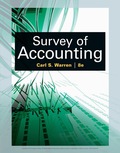
Survey of Accounting (Accounting I)
8th Edition
ISBN: 9781337517386
Author: WARREN
Publisher: Cengage
expand_more
expand_more
format_list_bulleted
Concept explainers
Textbook Question
Chapter 6, Problem 6.2MBA
Allowance method
Using transactions listed in £6-S. indicate the effects of each transaction on the liquidity metric days’ sales in receivables and profiability metric return on sales.
Expert Solution & Answer
Trending nowThis is a popular solution!

Students have asked these similar questions
general account
answer plz
Need help this question
Chapter 6 Solutions
Survey of Accounting (Accounting I)
Ch. 6 - At the end of the fiscal year, before the accounts...Ch. 6 - At the end of the fiscal year, Accounts Receivable...Ch. 6 - Prob. 3SEQCh. 6 - The following units of a particular item were...Ch. 6 - Prob. 5SEQCh. 6 - Prob. 1CDQCh. 6 - What types of transactions give rise to accounts...Ch. 6 - In what section of the balance sheet should a note...Ch. 6 - Give two examples of other receivables.Ch. 6 - Carter’s Hardware is a small hardware store in the...
Ch. 6 - Which of the two methods of accounting for...Ch. 6 - Prob. 7CDQCh. 6 - After the accounts are adjusted at the end of the...Ch. 6 - Prob. 9CDQCh. 6 - How are manufacturing inventories different from...Ch. 6 - Prob. 11CDQCh. 6 - Does the term last-in in the LIFO method mean that...Ch. 6 - If inventory is being valued at cost and the price...Ch. 6 - Prob. 14CDQCh. 6 - Prob. 15CDQCh. 6 - Prob. 16CDQCh. 6 - Prob. 17CDQCh. 6 - Prob. 18CDQCh. 6 - Prob. 6.1ECh. 6 - Determine due date and interest on notes Determine...Ch. 6 - Nature of uncollectible accounts MGM Resorts...Ch. 6 - Uncollectible accounts, using direct write-off...Ch. 6 - Uncollectible receivables, using allowance method...Ch. 6 - Writing off accounts receivable Quantum...Ch. 6 - Estimating doubtful accounts Easy Rider...Ch. 6 - Entry for uncollectible accounts Using the data in...Ch. 6 - Providing for doubtful accounts At the end of the...Ch. 6 - Effect of doubtful accounts on net income During...Ch. 6 - Effect of doubtful accounts on net income Using...Ch. 6 - Qualcomm Incorporated (QCOM) is a leading...Ch. 6 - Film costs of DreamWorks DreamWorks Animation SKG...Ch. 6 - Inventory by three methods The units of an item...Ch. 6 - Inventory by three methods; cost of goods sold The...Ch. 6 - Comparing inventory methods Assume that a firm...Ch. 6 - Prob. 6.17ECh. 6 - Lower-of-cost-or-market inventory On the basis of...Ch. 6 - Inventory on the balance sheet Based on thy data...Ch. 6 - Allowance method for doubtful accounts Averys...Ch. 6 - Allowance method for doubtful accounts Averys...Ch. 6 - Allowance method for doubtful accounts Averys...Ch. 6 - Allowance method for doubtful accounts Averys...Ch. 6 - Allowance method for doubtful accounts Averys...Ch. 6 - Allowance method for doubtful accounts Averys...Ch. 6 - Estimate uncollectible accounts For several years....Ch. 6 - Estimate uncollectible accounts For several years....Ch. 6 - Compare two methods of accounting for...Ch. 6 - Compare Two methods of accounting for...Ch. 6 - Inventory by three cost flow methods Details...Ch. 6 - Inventory by three cost flow methods Details...Ch. 6 - Inventory by three cost flow methods Details...Ch. 6 - Inventory by three cost flow methods Details...Ch. 6 - Lower-of-cost-or market inventory Data on the...Ch. 6 - Prob. 6.1MBACh. 6 - Allowance method Using transactions listed in...Ch. 6 - Prob. 6.3MBACh. 6 - Prob. 6.4MBACh. 6 - Lower of cost or market Using data in E6-18,...Ch. 6 - Prob. 6.6.1MBACh. 6 - Prob. 6.6.2MBACh. 6 - Accounts receivable and inventory turnover The...Ch. 6 - Prob. 6.6.4MBACh. 6 - Prob. 6.6.5MBACh. 6 - Prob. 6.6.6MBACh. 6 - Prob. 6.7.1MBACh. 6 - Prob. 6.7.2MBACh. 6 - Prob. 6.7.3MBACh. 6 - Prob. 6.7.4MBACh. 6 - Prob. 6.7.5MBACh. 6 - Prob. 6.7.6MBACh. 6 - Prob. 6.8MBACh. 6 - Prob. 6.9.1MBACh. 6 - Prob. 6.9.2MBACh. 6 - Prob. 6.9.3MBACh. 6 - Prob. 6.9.4MBACh. 6 - Prob. 6.9.5MBACh. 6 - Prob. 6.9.6MBACh. 6 - Prob. 6.10.1MBACh. 6 - Prob. 6.10.2MBACh. 6 - Prob. 6.10.3MBACh. 6 - Prob. 6.10.4MBACh. 6 - Prob. 6.10.5MBACh. 6 - Prob. 6.10.6MBACh. 6 - Prob. 6.1CCh. 6 - Collecting accounts receivable The following is an...Ch. 6 - Ethics and professional conduct in business...Ch. 6 - LIFO and inventory flowInstructions The following...
Knowledge Booster
Learn more about
Need a deep-dive on the concept behind this application? Look no further. Learn more about this topic, accounting and related others by exploring similar questions and additional content below.Similar questions
arrow_back_ios
SEE MORE QUESTIONS
arrow_forward_ios
Recommended textbooks for you
 Survey of Accounting (Accounting I)AccountingISBN:9781305961883Author:Carl WarrenPublisher:Cengage Learning
Survey of Accounting (Accounting I)AccountingISBN:9781305961883Author:Carl WarrenPublisher:Cengage Learning Intermediate Accounting: Reporting And AnalysisAccountingISBN:9781337788281Author:James M. Wahlen, Jefferson P. Jones, Donald PagachPublisher:Cengage Learning
Intermediate Accounting: Reporting And AnalysisAccountingISBN:9781337788281Author:James M. Wahlen, Jefferson P. Jones, Donald PagachPublisher:Cengage Learning College Accounting (Book Only): A Career ApproachAccountingISBN:9781337280570Author:Scott, Cathy J.Publisher:South-Western College Pub
College Accounting (Book Only): A Career ApproachAccountingISBN:9781337280570Author:Scott, Cathy J.Publisher:South-Western College Pub Financial And Managerial AccountingAccountingISBN:9781337902663Author:WARREN, Carl S.Publisher:Cengage Learning,
Financial And Managerial AccountingAccountingISBN:9781337902663Author:WARREN, Carl S.Publisher:Cengage Learning, College Accounting, Chapters 1-27AccountingISBN:9781337794756Author:HEINTZ, James A.Publisher:Cengage Learning,
College Accounting, Chapters 1-27AccountingISBN:9781337794756Author:HEINTZ, James A.Publisher:Cengage Learning,

Survey of Accounting (Accounting I)
Accounting
ISBN:9781305961883
Author:Carl Warren
Publisher:Cengage Learning

Intermediate Accounting: Reporting And Analysis
Accounting
ISBN:9781337788281
Author:James M. Wahlen, Jefferson P. Jones, Donald Pagach
Publisher:Cengage Learning

College Accounting (Book Only): A Career Approach
Accounting
ISBN:9781337280570
Author:Scott, Cathy J.
Publisher:South-Western College Pub

Financial And Managerial Accounting
Accounting
ISBN:9781337902663
Author:WARREN, Carl S.
Publisher:Cengage Learning,

College Accounting, Chapters 1-27
Accounting
ISBN:9781337794756
Author:HEINTZ, James A.
Publisher:Cengage Learning,
Accounts Receivable and Accounts Payable; Author: The Finance Storyteller;https://www.youtube.com/watch?v=x_aUWbQa878;License: Standard Youtube License